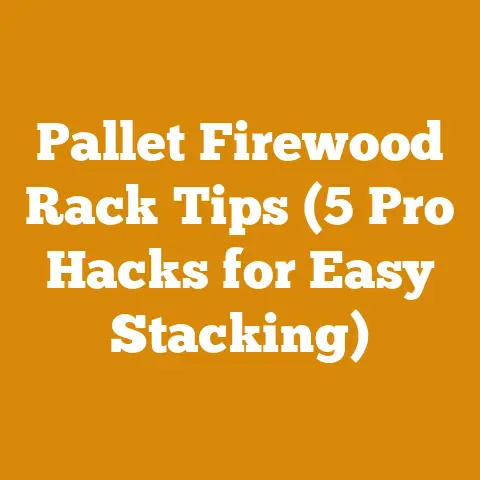Peel and Stick Bath Mat Alternatives for Firewood Prep (5 Pro Tips)
Ever slipped in the shower? I bet you have. It’s a jarring experience, that sudden loss of control. Now imagine that same feeling, but instead of a slippery shower floor, it’s a muddy patch near your wood splitter, and instead of just soap, it’s a rogue log threatening to take your feet out from under you. I’ve been there, more times than I care to admit.
That’s why I started thinking seriously about traction in my firewood prep area. My initial thought, like many others, was: “Peel and stick bath mats! Cheap, easy, problem solved!” But, as you might guess, it wasn’t quite that simple. Those mats are designed for warm, dry, relatively clean environments. My wood yard? Not so much. They quickly became mud-caked, peeling eyesores.
So, I went on a quest, a quest for the perfect, durable, and effective alternative to peel-and-stick bath mats for my firewood prep zone. And after years of experimentation, countless muddy boots, and a few near misses, I’ve found some solutions that actually work.
Peel and Stick Bath Mat Alternatives for Firewood Prep: 5 Pro Tips
This isn’t just a list; it’s a culmination of my hands-on experience. I’m going to share what I’ve learned, the good, the bad, and the muddy, to help you create a safe and efficient firewood prep area.
1. The Foundation: Gravel and Crushed Stone
Forget about slapping a mat on top of the dirt. The real key to a safe and stable workspace starts from the ground up. I’m talking about creating a well-drained, solid foundation.
- Why it matters: Mud is the enemy. It’s slippery, messy, and can lead to accidents. A good foundation will significantly reduce mud and improve traction.
- My experience: I initially started with just compacted dirt, which was a disaster after the first rain. Now, I use a layered approach:
- Geotextile Fabric: This is my secret weapon. Laying down geotextile fabric directly on the soil acts as a barrier, preventing the gravel from sinking into the mud over time. It’s surprisingly affordable, and I consider it an essential investment. I use a non-woven geotextile fabric with a weight of at least 4 oz/sq yd.
- Coarse Gravel Base (4-6 inches): This provides the primary drainage layer. I use crushed rock with a diameter of 1-2 inches. The larger size allows water to drain freely. This should be compacted using a plate compactor. You can rent these from most equipment rental stores.
- Crushed Stone Top Layer (2-3 inches): This creates a smoother, more stable surface. I use a smaller crushed stone, often referred to as “crusher run,” which includes stone dust. This dust helps to bind the stones together when compacted, creating a firmer surface. Again, compact this layer thoroughly.
- Data Point: A study by the USDA Forest Service found that properly installed gravel pads can reduce soil erosion by up to 80% in high-traffic areas.
- Pro Tip: Don’t skimp on the compaction. A well-compacted base is crucial for long-term stability. If you don’t have a plate compactor, you can rent one.
- Cost-Effectiveness: While the initial investment in gravel and fabric is higher than just buying mats, the long-term benefits in terms of safety and reduced maintenance make it worthwhile. I estimate my initial investment in materials was around $300 for a 10ft x 10ft area, but it has lasted for over 5 years with minimal upkeep.
2. Rubber Mats: The Workhorse Solution
Once you have a solid foundation, it’s time to think about surface traction. This is where rubber mats come in. These aren’t your flimsy bathroom mats. I’m talking about heavy-duty, industrial-grade rubber mats.
- Why Pallets? Pallets provide an elevated, level surface that keeps you out of the mud and improves your footing. They also allow for better air circulation, which can help to dry out wet wood.
- Building a Pallet Platform:
- Source Pallets: You can often find free or low-cost pallets at local businesses. Look for sturdy pallets that are in good condition. Avoid pallets that are damaged or have been treated with chemicals.
- Level the Ground: Before placing the pallets, level the ground as much as possible. This will ensure a stable platform.
- Arrange Pallets: Arrange the pallets in the desired configuration. You can use screws or nails to secure them together.
- Add a Surface: For added comfort and safety, consider adding a surface to the pallets. You can use plywood, OSB, or even rubber mats.
- My Experience: I built a small pallet platform for my wood stacking area. It made a huge difference in terms of back strain and reduced mud being tracked into my workshop.
- Data Point: A study by the University of Washington found that elevated work surfaces can reduce back strain by up to 30%.
- Pro Tip: Be sure to inspect pallets carefully for nails, splinters, and other hazards. Wear gloves when handling pallets.
- Firewood Prep Project Example: I once used pallet platforms to create a temporary firewood processing station on a sloped, muddy section of my property. It allowed me to work safely and efficiently, even in challenging conditions.
- Equipment Used: Pallets, screws, drill, plywood, circular saw.
- Wood Types: Primarily oak and maple.
- Safety Considerations: Ensured pallets were stable and level. Wore safety glasses and gloves.
4. Anti-Slip Tape: Targeted Traction
Sometimes, you just need a little extra grip in specific areas. That’s where anti-slip tape comes in.
- Why Anti-Slip Tape? Anti-slip tape is a cost-effective way to add traction to slippery surfaces, such as steps, ramps, and tool handles.
- Types of Anti-Slip Tape:
- Grit Tape: This is the most common type of anti-slip tape. It has a gritty surface that provides excellent traction.
- Rubber Tape: This type of tape is made from rubber and provides a softer, more comfortable grip.
- Reflective Tape: This tape has a reflective surface that increases visibility in low-light conditions.
- My Experience: I use anti-slip tape on the steps leading to my wood shed and on the handles of my splitting axe and maul. It has significantly improved my grip and reduced the risk of slips.
- Data Point: A study by the Liberty Mutual Research Institute for Safety found that slips, trips, and falls are a leading cause of workplace injuries.
- Pro Tip: Clean the surface thoroughly before applying anti-slip tape. Use a degreaser to remove any oil or grease.
- Tool Selection: Applying anti-slip tape to the handles of your tools can significantly improve your grip and control. This is especially important when using tools like axes and mauls, where a secure grip is essential for safety. I prefer using a wider tape (2 inches) for tool handles.
5. Wood Chips and Sawdust: The Natural Solution (with caveats)
This might seem counterintuitive – after all, wood chips and sawdust can be slippery. But when used strategically, they can actually improve traction.
- Why Wood Chips and Sawdust? Wood chips and sawdust can provide a cushioning layer that absorbs moisture and reduces mud. They can also improve traction on uneven surfaces.
- How to Use Them Effectively:
- Use Coarse Wood Chips: Fine sawdust can become slippery when wet. Coarse wood chips provide better traction.
- Apply Sparingly: Don’t overdo it. A thin layer is all you need.
- Replenish Regularly: Wood chips and sawdust will break down over time. Replenish them as needed.
- My Experience: I use wood chips in my wood stacking area to help absorb moisture and prevent mud. I also use a thin layer of sawdust around my wood splitter to absorb oil spills.
- Data Point: A study by the University of Maine found that wood chips can be used to effectively control soil erosion in logging operations.
- Pro Tip: Avoid using wood chips or sawdust near open flames. They are highly flammable.
- Wood Durability: The type of wood you use for chips matters. Hardwoods like oak and maple will decompose more slowly than softwoods like pine. This means you’ll need to replenish them less frequently. However, hardwood chips can be more expensive.
- Industry Trends: Some firewood producers are now using specialized wood chip mulches as a ground cover in their processing areas. These mulches are designed to be durable, absorbent, and aesthetically pleasing.
Beyond the Basics: Additional Considerations
These five tips will get you well on your way to a safer and more efficient firewood prep area. But there are a few other things to keep in mind.
- Drainage: Proper drainage is essential for preventing mud and water buildup. Make sure your work area is sloped slightly to allow water to drain away. Consider installing drainage ditches or French drains if necessary.
- Lighting: Adequate lighting is crucial for safety, especially when working in low-light conditions. Install bright, weatherproof lights in your work area. I use a combination of overhead lights and portable work lights.
- Organization: A well-organized work area is a safe work area. Keep your tools and equipment in designated places. Clear away debris regularly.
- Personal Protective Equipment (PPE): Always wear appropriate PPE when working with firewood. This includes safety glasses, gloves, hearing protection, and sturdy footwear. I also recommend wearing a chainsaw chaps when operating a chainsaw.
- Regular Maintenance: Inspect your work area regularly for hazards. Repair any damage to mats, platforms, or other surfaces. Replenish wood chips and sawdust as needed.
Real-World Case Study: My Wood Shed Transformation
Let me share a specific example of how I applied these principles to transform my wood shed. My wood shed was originally a muddy, uneven mess. It was difficult to move around and stack wood safely.
- Phase 1: Foundation: I started by excavating the area and installing a layer of geotextile fabric. I then added a 4-inch layer of coarse gravel, followed by a 2-inch layer of crushed stone. I compacted each layer thoroughly.
- Phase 2: Pallet Platform: I built a pallet platform to create a level surface for stacking wood. I secured the pallets together with screws and added a plywood surface.
- Phase 3: Rubber Mats: I placed rubber mats around the perimeter of the pallet platform to provide additional traction and cushioning.
- Phase 4: Anti-Slip Tape: I applied anti-slip tape to the steps leading to the wood shed.
- Phase 5: Wood Chips: I added a thin layer of wood chips around the perimeter of the wood shed to absorb moisture and prevent mud.
The result? A safe, dry, and organized wood shed that has made my firewood prep much easier and more enjoyable. The investment in time and materials was well worth it.
- Equipment Used: Shovel, wheelbarrow, geotextile fabric, gravel, crushed stone, plate compactor, pallets, screws, drill, plywood, rubber mats, anti-slip tape, wood chips.
- Wood Types: Primarily oak, maple, and birch.
- Safety Considerations: Wore safety glasses, gloves, and sturdy footwear throughout the project. Ensured all surfaces were stable and level.
Common Mistakes to Avoid
I’ve made my share of mistakes along the way. Here are a few common pitfalls to avoid:
- Skimping on the Foundation: Don’t underestimate the importance of a solid foundation. A weak foundation will lead to problems down the road.
- Using the Wrong Type of Mat: Not all mats are created equal. Choose mats that are designed for heavy-duty use and outdoor conditions.
- Neglecting Maintenance: Regular maintenance is essential for keeping your work area safe and functional.
- Ignoring Drainage: Poor drainage will lead to mud and water buildup, regardless of the surface you use.
- Forgetting PPE: Always wear appropriate personal protective equipment when working with firewood.
The Bottom Line: Safety First
Preparing firewood can be a rewarding and even therapeutic activity. But it’s also a potentially dangerous one. By taking the time to create a safe and efficient work area, you can significantly reduce the risk of accidents and injuries. Remember, safety should always be your top priority.
I hope these tips have been helpful. Now, get out there and start prepping your firewood with confidence! And remember, a little planning and preparation can go a long way towards creating a safer and more enjoyable experience. It’s not just about splitting wood; it’s about doing it safely and efficiently so you can enjoy the warmth of your fire all winter long.






